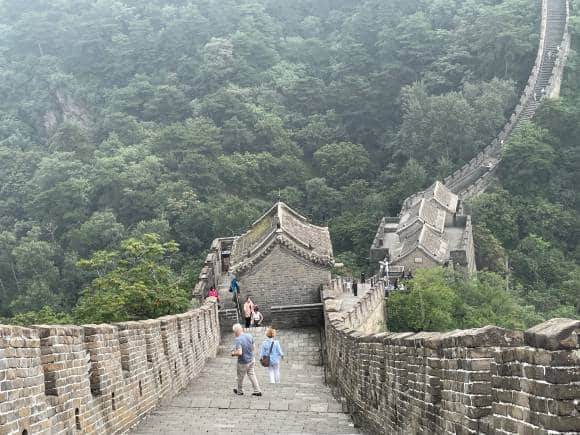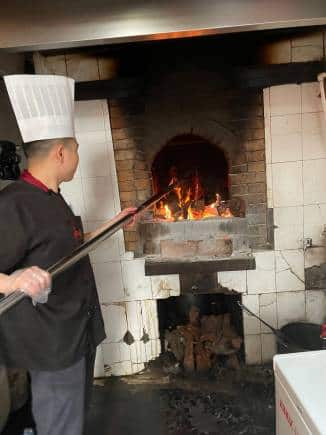



From a vertiginous lookout point, I soak in a breathtaking view of precipitous gorges and verdant foliage surrounding China’s most iconic monument — the Great Wall. Draped dreamily across contiguous mountains, the gigantic structure branches off into different directions before disappearing mysteriously into the horizon, its beige concrete contrasting sharply all along with the valley’s emerald.
Over 27,000 people visit the site daily through several entry points, some offering unique hiking opportunities as well as they wind through towering mountains and valleys. My route — the Mutianyu path in Huairou Country, 73 km from downtown Beijing connected the Jiankou Great Wall in the west and the Gubeikou Great Wall in the east. A masterpiece of restoration with 23 original-style watchtowers, it offered plenty of photo stops along the way.
 The Great Wall of China. (Photo: Neeta Lal)
The Great Wall of China. (Photo: Neeta Lal)I cross mildly steep gradients before boarding an open cable car experiencing the full elemental assault of the sun and the wind on my limbs during the dizzying ascent. The heart somersaulted each time the vehicle lurched forward noisily, the thought of plunging to my death in the cavernous depths below mortifying me no end.
However, the adventure is well worth it. As one is disgorged at the top on the mighty stony structure, childish glee is appropriate, whatever your age. The Wall is indeed an engineering marvel making one wonder how the construction material was transported to such heights for the project. Constructed from 3 BC to 17th century AD by soldiers and convicts, the Wall is also a contentious piece of architecture with as many as 400,000 laborers dying during its construction, many of them buried within the structure itself.
Steeped in historyBeijing redefines and reinvents itself constantly. Centuries-old historical sights stand cheek-by-jowl with cutting edge architecture, the old with the new, the modern with the medieval. The city’s split personality offers visitors an intriguing peek into its tumultuous past as well as a chance to savor all the modern comforts of a global metropolis.
Apart from a sumptuous smorgasbord of culture, art, nature, entertainment and nightlife, good food and shopping is also on offer. Atmospheric museums and art galleries add to this exciting mix. The formidable National Art Museum of China traces the 5,000-year-old Chinese civilisation through landmark events such as the Opium War, the 70-year exploration since the founding of the People’s Republic of China, the 40 years of reform and opening-up. Over 1.4 million exhibits are on display here, many of them classified as national treasures and of great historical, cultural, scientific and artistic value.
 The National Art Museum of China, in Dongcheng, Beijing. (Photo: Neeta Lal)
The National Art Museum of China, in Dongcheng, Beijing. (Photo: Neeta Lal)Exhibitions at the National Art Museum are well-thronged events. I view a beautifully curated one by legendary Georgian artist Zurab Konstantinovich Tsereteli famous as ‘Georgia’s Picasso’. Titled More than Life, it included over 80 paintings, enamel works and sculptures by the octogenarian artist. Garnering rave reviews from Chinese art critics as well as the visiting public, it paid a tribute to the maestro whose impressive oeuvre spans oils, sculptures, murals, mosaics, installations and ceramics.
 Works by Georgian artist Zurab Tsereteli on display at the National Art Museum of China in Beijing. (Photos: Neeta Lal)
Works by Georgian artist Zurab Tsereteli on display at the National Art Museum of China in Beijing. (Photos: Neeta Lal)For those looking for less gravitas in their outings, the evocative Watermelon Museum, the world’s only such place celebrating the fruit, makes for a fun, immersive experience. Located in Panggezhuang Town, its architecture is uniquely eye-catching. Shaped like a gigantic watermelon offset by two large green leaves, it has been nicknamed “the flying watermelon” symbolising the fruit’s soaring production in China’s Daxing region.
 Entrance into the Forbidden City palace complex in Dongcheng District, Beijing, China. (Photo: Neeta Lal)
Entrance into the Forbidden City palace complex in Dongcheng District, Beijing, China. (Photo: Neeta Lal)Beijing is a trove of UNESCO World Heritage that includes the Summer Palace, Temple of Heaven, the Ming Tombs, the Grand Canal, among others. The Forbidden City or the Palace Museum, earlier home to the Ming and Qing dynasties is located smack dab in the heart of Beijing. A remarkable portrayal of Chinese history, culture, civilisation, and architecture, it is also the world’s largest palace complex with almost 1,000 buildings and 9,999 rooms!
I amble around its premises soaking in an Instagrammable ensemble of quaint wooden structures and courtyards brimming with imperial treasures. Verdant gardens and pavilions (that served as a former playground for the imperial court) make for wholesome viewing with Kunming Lake girding the structure like a bejeweled belt.
A bite of Beijing Peking duck being roasted. (Photo Neeta Lal)
Peking duck being roasted. (Photo Neeta Lal)Beijing offers an incredible repertoire of tasty treats. From homey establishments serving local cuisine to spiffy eateries dishing out gourmet global fare, it has all budgets covered. Sampling the city’s most iconic dish — the Peking Duck — is an unforgettable experience. I try it at a traditional and atmospheric eatery in a labyrinthine lane in downtown Beijing. The chef roasts the impaled bird to a gossamer gold in a traditional clay oven before slicing it wafer thin displaying all the skills of an artisan.
 Famous Peking duck lunch. (Photo: Neeta Lal)
Famous Peking duck lunch. (Photo: Neeta Lal)The duck arrives with drama on the table on a large platter with accompaniments like paper-thin pancakes, spring onions, sliced vegetables and plum sauce. I dunk slices of the bird in the sauce, place it on the pancake and dig in, its melt-in-the-mouth texture creating a party in my mouth!
Street smartTo get a glimpse of old Beijing, before it got caught in the vortex of an aggressive gentrification in the 1970s, I head to Gulou Street. The area houses the city’s fast vanishing traditional neighborhoods called ‘hutongs’. Very few of these charming areas with narrow lanes and single story courtyard houses remain today thanks to untrammeled urban ‘development’.
Away from the confines of my spiffy hotel and dazzling malls I’d been shopping in, the hutongs transported me back in time to a sepia-tinted era with lanes resembling a chessboard, delicate gardens, fine rockeries and ancient ruins. As one of the most representative icons in local culture, the best hutongs nestle around the Drum and Bell Towers, two landmark buildings that were used for telling time since the 13th century. Here, I play the tourist to the hilt watching the locals go about their lives, gossiping, working, eating and shopping from kiosks selling all manner of goods.
Fitness is funThere’s no dearth of free activities to indulge in the Chinese capital. An early morning stroll in one its many public parks, brimming with hundreds of elderly doing their healthy morning routines, is a live tutorial in how to center oneself in this crazy, chaotic megapolis. Observing senior citizens practicing tai chi, playing badminton, walking backwards, and flying kites to dancing, singing, clapping, and exercising on gym equipment fixed to the park grounds, is a full on sensory experience. It is also a valuable lesson in how ageing can also be fun if you take care of your mind and body.
Discover the latest Business News, Sensex, and Nifty updates. Obtain Personal Finance insights, tax queries, and expert opinions on Moneycontrol or download the Moneycontrol App to stay updated!
Find the best of Al News in one place, specially curated for you every weekend.
Stay on top of the latest tech trends and biggest startup news.